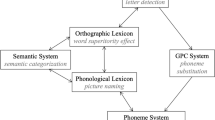Abstract
The purpose of this study is to examine factors that influence students’ reading of derived words. Recent research suggests that the lexical quality of a derived word depends on the familiarity of the word, its morphemic constituents (i.e., base word and affixes), and the frequency with which the base word appears in other words (i.e., members of the same word family or family frequency). On the premise that better and more experienced readers have higher quality lexical representations, we explore the extent to which accuracy of reading derived words by 4th and 6th graders is related to measures of familiarity, including derived and base word frequencies, family size, average family frequency, and word length. The results of an exploratory factor analysis indicated that these measures formed two factors, one representing morphemic constitution and the second representing exposure to the word family; both factors accounted for significant variance in the students’ derived word reading. Comparisons of sets of derived words contrasted on familiarity properties showed that performance on derived words, overall, is better for 6th than 4th graders and for good than poor readers. On the measures of family frequency and family size, there were significant discrepancies between grade level and reading ability and frequency characteristics. These add support to the view that morphemic analysis and wide reading experience contribute to derived word reading.
Similar content being viewed by others
References
Berninger V. B., Nagy W. E., Carlisle J. F., Thomson J., Hoffer D., Abbott S., Abbott R., Richards T. and Aylward E. (2003). Effective treatment for children with dyslexia in grades 4–6: Behavioral and brain evidence. In: Foorman, B. (eds) Preventing and remediating reading difficulties: Bringing science to scale, pp 381–347. York Press, Baltimore
Bertram R., Baayen R. H. and Schreuder R. (2000). Effects of family size for complex. Journal of Memory and Language 42: 390–405
Carlisle J. F. (2000). Awareness of the structure and meaning of morphologically complex words: Impact on reading. Reading and Writing: An Interdisciplinary Journal 12: 169–190
Carlisle J. F. and Stone C. A. (2005). Exploring the role of morphemes in word reading. Reading Research Quarterly 40: 428–449
Carlisle J. F., Stone C. A. and Katz L. A. (2001). The effects of phonological transparency on reading derived words. Annals of Dyslexia 51: 249–274
Carroll J. B., Davies P. and Richman B. (1971). Word frequency book. American Heritage Publishing Company, New York
Ehri L. C. (1998). Grapheme–phoneme knowledge is essential for learning to read words in English. In: Metsala, J. L. and Ehri, L. C. (eds) Word recognition in beginning literacy, pp 3–40. Lawrence Erlbaum, Mahwah, NJ
Fowler A. E. and Liberman I. Y. (1995). The role of phonology and orthography in morphological awareness. In: Feldman, L. B. (eds) Morphological aspects of language processing, pp 157–188. Lawrence Erlbaum, Hillsdale, NJ
Frederiksen J. R. and Kroll J. F. (1976). Spelling and sound: Approaches to the internal lexicon. Journal of Experimental Psychology 2: 361–379
Gorsuch R. L. (1983). Factor analysis. Lawrence Erlbaum, Hillsdale, NJ
Leong C. K. (1989). Productive knowledge of derivational rules in poor readers. Annals of Dyslexia 39: 94–115
Mann V. and Singson M. (2003). Linking morphological knowledge to English decoding ability: Large effects of little suffixes. In: Assink, E. M. H. and Sandra, D. (eds) Reading complex words: Cross-linguistic studies, pp 1–25. Kluwer Academic, New York
Nagy W. E. and Anderson R. (1984). How many words in printed school English?. Reading Research Quarterly 19: 304–330
Nagy W. E., Anderson R., Schommer M., Scott J. A. and Stallman A. C. (1989). Morphological families and word recognition. Reading Research Quarterly 24: 262–282
Perfetti C. A. (1992). The representation problem in reading acquisition. In: Gough, P., Ehri, L. and Treiman, R. (eds) Reading acquisition, pp 107–143. Lawrence Erlbaum, Hillsdale, NJ
Perfetti C. A. and Hart L. (2001). The lexical bases of comprehension skill. In: Gorfien, D. S. (eds) On the consequences of meaning selection: Perspectives on resolving lexical ambiguity, pp 67–86. American Psychological Association, Washington, DC
Reichle E. D. and Perfetti C. A. (2003). Morphology in word identification: A word experience model that accounts for morpheme frequency effects. Scientific Studies of Reading 7: 219–237
Schreuder R. and Baayen R. H. (1997). How complex simple words can be. Journal of Memory and Language 36: 118–139
Schreuder R., Burani C. and Baayen H. (2003). Parsing and semantic opacity. In: Assink, E. M. H. and Sandra, D. (eds) Reading complex words: Cross-language studies, pp 159–189. Kluwer Academic, New York
Singson M., Mahoney D. and Mann V. (2000). The relation between reading ability and morphological skills: Evidence from derivational suffixes. Reading and Writing: An Interdisciplinary Journal 12: 219–252
Stanovich K. E. (1986). Matthew effects in reading: Some consequences of individual differences in the acquisition of literacy. Reading Research Quarterly 21: 360–407
Taft M. (1979). Recognition of affixed words and the word frequency effect. Memory and Cognition 7: 263–272
Taft M. (2003). Morphological representation as a correlation between form and meaning. In: Assink, E. G. H. and Sandra, D. (eds) Reading complex words: Cross language studies, pp 113–137. Kluwer Academic, New York
Taft M. and Zhu X. (1995). The representation of bound morphemes in the lexicon: A Chinese study. In: Feldman, L. B. (eds) Morphological aspects of language processing, pp 293–316. Lawrence Erlbaum, Hillsdale, NJ
Verhoeven L., Baayen H. and Schreuder R. (2004). Orthographic constraints and frequency effects in complex word identification. Written language and literacy 7: 49–59
Woodcock R. W. and Mather N. (2000). Woodcock-Johnson Psychoeducational Battery-III. Riverside, Itasca, IL
Author information
Authors and Affiliations
Corresponding author
Rights and permissions
About this article
Cite this article
Carlisle, J.F., Katz, L.A. Effects of word and morpheme familiarity on reading of derived words. Read Writ 19, 669–693 (2006). https://doi.org/10.1007/s11145-005-5766-2
Published:
Issue Date:
DOI: https://doi.org/10.1007/s11145-005-5766-2



